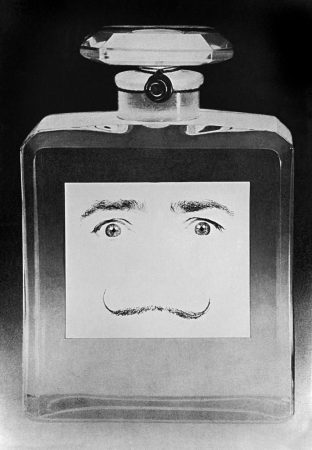
When asked by famed portrait photographer Philppe Halsman what his favorite perfume was, Dalí responded by crafting this bottle. ©Phillipe Halsman, 1955, from Magnum Photos.
Salvador Dalí wanted to smell like a ram. Eau de cologne made him ill; he wanted to smell like the ram that passed by his window every day. Dalí was consumed with the idea of the scent. His confidence in his creative abilities sent him into his studio. He lit an alcohol burner, boiled some water, and threw in a few noxious materials from his etching supplies.
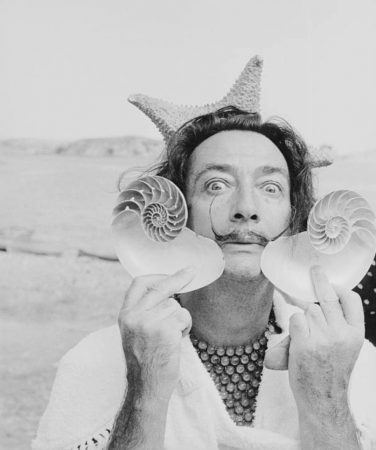
Salvador Dali is channeling his inner ram, or is it the Sun King? ©Charles Hewitt, Cadaqués, Catalonia, 1955.
His nose was still not satisfied; needing something more animalic, Dalí added aspic and goat manure from his backyard. There, he’d done it! Smearing the mixture on his body transformed him into that ram. Olfactory quest complete, Dalí’s lifelong relationship with perfume had reached a new level.
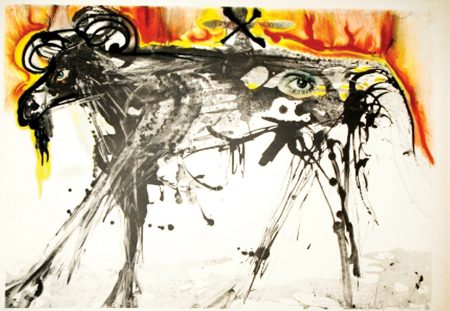
Throughout Dalí’s life a ram was often the subject of his paintings. This ram is from 1971. ©Salvador Dalí, 1971, from the Salvador Dalí Society.
As Dalí grew apart from the Surrealist movement in the 1930s and ’40s, his increasing comfort with the commercial use of his art earned him the disdain of the Surrealists in France. André Breton, one of the founders of the movement, coined the nickname “Avida Dollars”, an anagram of “Salvador Dalí” which is also a phonetic pun of “eager for dollars” in French. The line between art and commerce is taken for granted after 75 years; whether it’s a perfume advertisement or a surrealist masterpiece, Dalí remains Dalí.
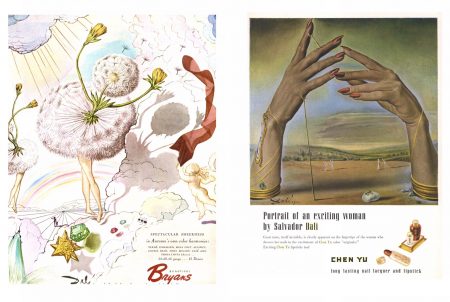
During World War II when he lived in New York, he created a number of ads, primarily for fashion and beauty companies. Above are advertisements for hosiery and cosmetics, ca. 1944.
Elsa Schiaparelli was one of the first to persuade Dalí to create outside the fine art bubble. His collaborations with her in the 1930’s are among Schiaparelli’s most famous: the lobster dress, the shoe hat, and the skeleton dress. To celebrate the end of WWII, and express the joy felt in France, Schiaparelli released the exultant perfume Le Roy Soleil in 1946. Dalí designed both its flacon and case. A golden scallop shell à la Venus held the magical Baccarat crystal bottle whose dauber was a golden sun. Even the smallest detail of the bottle celebrated the end of the war. Doves of peace in flight make up the sun’s features. This limited edition bottle was such a work of art that Wallis Simpson removed a framed photo of the Duke of Windsor from her dressing table to make room for the perfume. Closing the circle of Le Roy Soleil’s visual identity, Dalí also created the art for the Le Roy Soleil’s ad campaign, reaching back into French history to visit Louis XIV and his perfumed court.
.
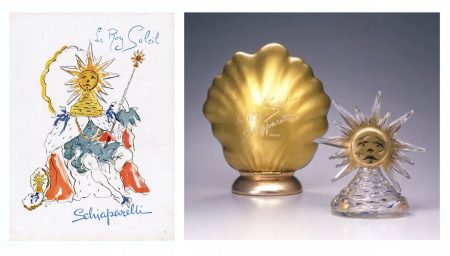
Vive le France! Dalí’s first perfume bottle and packaging design was for Schiaparelli’s Le Roy Soleil. Baccarat created a limited edition of about 3,000 sets.
The same year across the Atlantic, William Schultz, owner of the American cosmetics company Shulton and its Leigh line of perfumes, hired Dalí. Leigh was developing Desert Flower, a fragrance which was meant to evoke a pure flower flourishing in a barren landscape. That was the only direction Schultz gave the painter when he commissioned him to interpret the concept in his increasingly popular style. The result was a series of three paintings, “Trilogy of the Desert”. One of the trio, “Invisible Lovers”, was selected for the ad campaign, complete with promotional tour. To market the new perfume, department stores around the Americas took turns displaying the original painting while they gave away posters of the work as gifts with purchase.

Dalí also created typography for Desert Flower. One can’t help but see a similarity to the font used for the Harry Potter movies fifty years later.
Throughout the 1950s and ‘60’s Salvador Dalí and his work became recognizable to the masses. Capitalizing on his fame, in 1957 the French perfume company Marquay latched on to Dalí. They commissioned the artist to design the bottles, packaging, and ads for two of its fragrances, Monsieur Marquay and Rock n’ Roll, a.k.a. Coup de Feu (tr. Gunshot.) Marquay’s aim with Rock n’ Roll was to capture the “flame and explosion of the spirit of youth” that was happening in music (Elvis’s “All Shook Up” was the #1 hit that year.)
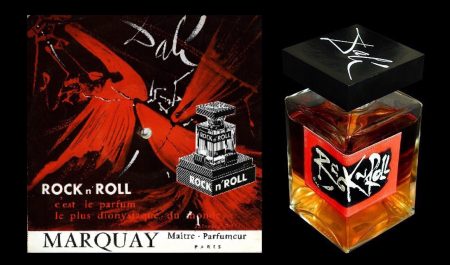
Marquay promised that its ambery fragrance for women, Rock n’Roll, was the most dionysiac in the world. Imagine that launch party. Ad and bottle, ca. 1957.
During the ‘60s and ‘70s Dalí’s work was still being featured in perfume advertisements like those for Lenthéric 12 and Rochas Femme. Lenthéric 12 is so named because the fragrance brand asked 12 artists to interpret a woman’s essence, Dalí being their favorite. Likewise, for their ad campaigns Rochas paired their perfumes with a piece of fine art. Femme received Dalí’s sculpture “Anti-Fleur
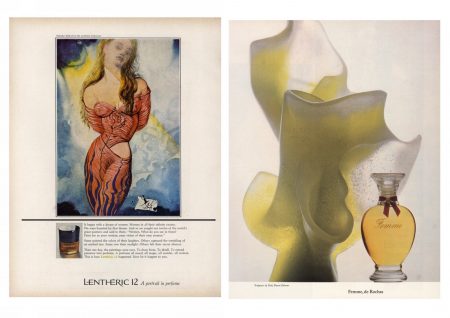
Lenthéric advertisement, 1968 and Rochas advertisement, 1974.
With Dalí’s connection to fragrance firmly established, some in the industry thought it was time for the painter to lend his name to his own line of perfumes. The owner of Shulton hosted a dinner in New York in 1971. His guests were Salvador and Gala Dalí seated next to bottle designer Pierre Dinand. The company was pleased with their collaboration with Dalí on Desert Flower, so pleased that they broached the idea of producing Dalí’s own perfume for him, starting with the packaging. Dinand, fresh from designing the iconic Yves Saint Laurent Rive Gauche bottle, was to execute the design with Dalí. The pair spent years discussing the project, meeting in New York and Europe, but no design was ever finalized. Dalí’s ideas were impossible to render in glass so the project fizzled. There was once a drawer filled with sketch after sketch, but sadly Dinand has no idea where they’ve gotten to.
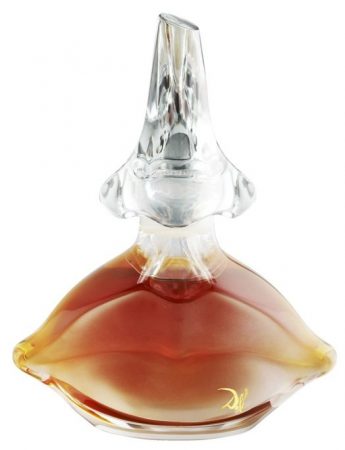
Salvador Dalí parfum, 1983. The bottle is based on the artist’s painting, “Apparition of the Aphrodite of Knidos”.
In 1983 a young perfumer named Albert Morillas was asked to create a perfume for Salvador and Gala Dalí. Of course the painter designed the bottle and Baccarat created it in crystal. There was a limited release of 1,500 bottles, each priced at $4,000 with a refill available for $600. At this point in Dalí’s life, it was the fame of the artist that gave more value to the perfume than the jus itself. At last before he died, Salvador Dalí had his own perfume, even if it didn’t smell like a ram.
– Marianne Butler, Sr. Contributor
